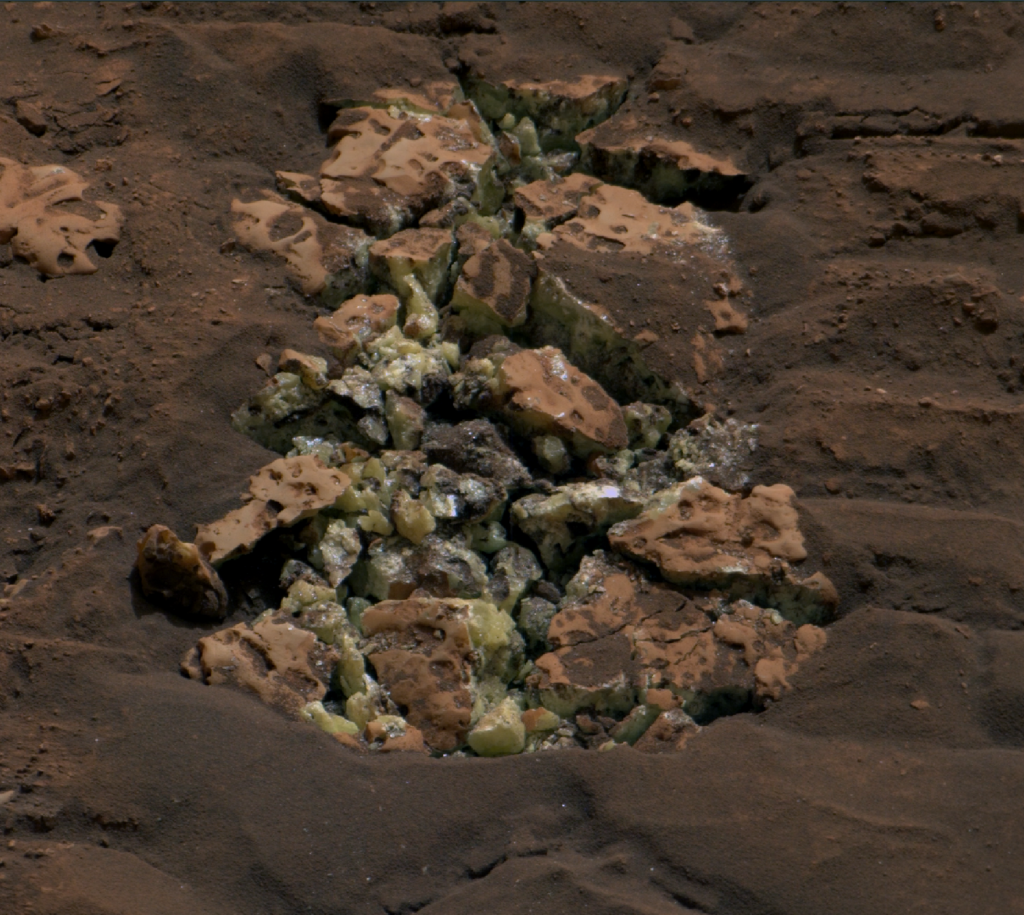
NASA’s Curiosity rover has made a groundbreaking discovery by identifying rocks composed of pure sulfur on Mars, marking the first time such an elemental form has been observed on the planet. This unexpected finding occurred on May 30, when the rover fractured a rock, exposing bright yellow sulfur crystals. This is the first Sulfur Discovered on Mars by Curiosity Rover.

On May 30, NASA’s Curiosity rover drove over a rock, cracking it open to reveal yellow crystals. Using an instrument on the rover’s arm, scientists confirmed these crystals are elemental sulfur, marking the first discovery of this kind on Mars. Photo Credit: NASA/JPL-Caltech/MSSS
Context and Exploration
Since October 2023, the Curiosity rover has been examining a Martian region abundant with sulfates—salts containing sulfur that typically form as water evaporates. Historically, detections in this area have involved sulfur-based minerals, which are combinations of sulfur and other elements. However, the recent sulfur discovered on Mars is pure, elemental sulfur. The relationship between this elemental sulfur and the previously identified sulfur-based minerals remains unclear.
Geological Implications
Elemental sulfur discovered on Mars, unlike the sulfur compounds responsible for the smell of rotten eggs, is odorless. It forms under specific conditions not previously associated with the region’s geological history. The presence of an entire field of sulfur rocks has raised questions about the local geological processes.
Scientific Significance
Curiosity’s project scientist, Ashwin Vasavada from NASA’s Jet Propulsion Laboratory, compared the sulfur discovered on Mars to finding an oasis in a desert, emphasizing its unexpected nature and the need for further investigation. This discovery underscores the excitement and unpredictability of planetary exploration.
Gediz Vallis Channel Exploration
Curiosity has been exploring the Gediz Vallis channel, which winds down Mount Sharp, a 3-mile-tall (5-kilometer-tall) mountain that the rover has been ascending since 2014. Each geological layer of Mount Sharp represents different periods in Martian history. Curiosity’s mission is to understand the ancient Martian environment and its potential to support microbial life, now highlighted by the sulfur discovered on Mars.

Flood and Landslide Evidence
Scientists hypothesize that Gediz Vallis was formed by flows of water and debris, leaving behind ridges of boulders and sediment. Recent observations suggest that both floodwaters and landslides contributed to the debris mounds in the channel. Rounded stones indicate water transport, while angular rocks suggest deposition by landslides. The sulfur discovered on Mars adds another layer of complexity to this geological landscape.
Sampling and Analysis
On June 18, Curiosity drilled into a large rock dubbed “Mammoth Lakes” to obtain a sample for analysis. The powdered rock was analyzed using instruments within the rover to determine its composition. This analysis complements the sulfur discovered on Mars by providing more context to the region’s mineralogy.
Ongoing Mission
Curiosity continues its mission, advancing towards new areas within Gediz Vallis channel to uncover more geological surprises. The rover’s discoveries, including the sulfur discovered on Mars, are managed by NASA’s Jet Propulsion Laboratory and contribute to our understanding of Mars’ geological history and its potential to support life.
Other Ongoing NASA Missions
If you are interested in learning more about other ongoing NASA missions, check out this article on What is the Nasa Artemis Program.

